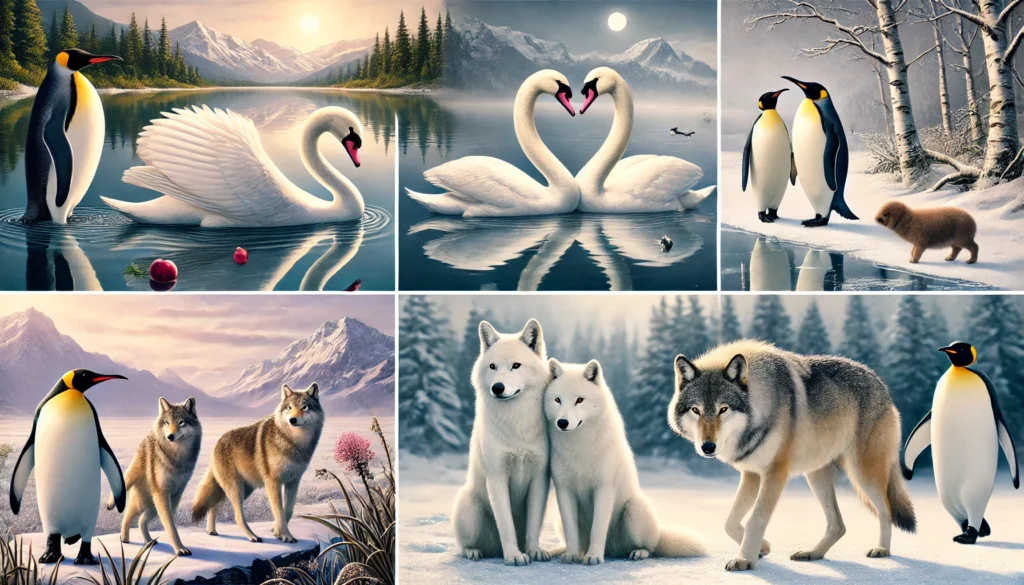In the animal kingdom, mating for life is a rare and remarkable phenomenon. While many species form short-term bonds based on seasonal or reproductive needs, there are certain animals that commit to one partner for life, forging lasting connections that are often compared to human monogamy. These animals exhibit loyalty, cooperation, and partnership, offering a glimpse into the power of long-term bonds in nature. Below, we explore ten animals that stay together for life and the fascinating adaptations that help them maintain their enduring relationships.
Swans: Symbols of Love and Devotion
Swans are often seen as symbols of love and fidelity, and for good reason. These graceful birds are known to form monogamous bonds that last for life. Once swans find a partner, they remain together, not only for mating but also for building nests and raising their young. The pair work in unison to protect their territory and care for their offspring, demonstrating remarkable cooperation and commitment.
One of the most iconic behaviors of swans is the way they swim together in synchrony, often touching their heads and necks in a heart-shaped formation. This courtship display is a testament to their strong bond. While rare, if a partner dies, the surviving swan may go through a period of mourning before eventually finding another mate.
Penguins: Dedicated Parents of the Frozen Tundra
Among the most famous animals that mate for life are penguins, particularly the emperor and Adélie penguins. These birds endure some of the harshest conditions on Earth, yet their strong bonds help them survive. Emperor penguins are known for their shared parenting duties, with the male taking over incubating the egg while the female goes to sea to feed. The pair must rely on one another to successfully raise their chick in the icy Antarctic environment.
Adélie penguins, on the other hand, return to the same partner year after year during breeding season. They build nests together and take turns guarding the eggs and hunting for food. Their mutual commitment ensures the survival of their young in the challenging conditions of their frozen habitat.
Wolves: Pack Bonds and Family Life
Wolves are highly social animals that live in packs, where the alpha pair usually mates for life. These lifelong partnerships form the foundation of the pack’s social structure, with the alpha male and female leading and raising their offspring together. The pair works closely to protect their territory, hunt, and ensure the well-being of the pack.
Wolves are known for their cooperative behavior, with each member of the pack playing a role in caring for the young and hunting. The strong bond between the alpha pair sets an example for the rest of the pack, demonstrating the importance of unity and loyalty within their social group.
Beavers: Builders and Lifelong Partners
Beavers are another species known for their monogamous relationships. These industrious animals not only build complex dams and lodges together but also maintain a lifelong bond with their mate. Beavers work together to raise their young, which stay with the parents for two years before venturing out on their own.
The monogamous nature of beavers is essential to their success in constructing and maintaining their elaborate homes. Both partners contribute to building the dam, gathering food, and protecting the family from predators. Their partnership is a key factor in their ability to thrive in their aquatic environment.
Bald Eagles: Majestic Mates for Life
Bald eagles, the national bird of the United States, are also known for their long-term monogamous relationships. These majestic raptors typically form lifelong bonds with their partners, working together to build large nests called eyries high up in trees or on cliffs. These nests are often reused and added to each year, growing larger as the pair returns to the same location season after season.
Bald eagles engage in impressive courtship displays, including aerial acrobatics and synchronized flying. Once a pair has mated, they work together to incubate the eggs and raise their young. Both parents share the responsibilities of hunting and feeding the chicks until they are ready to fledge. Their strong partnership is vital to the success of raising their offspring in the wild.
Gibbons: Monogamous Apes of the Forest
Gibbons are one of the few primates known to practice monogamy, forming long-term bonds with their partners. These small apes live in the dense forests of Southeast Asia, where they form family groups consisting of a mated pair and their offspring. Gibbons are known for their incredible agility, swinging through the treetops with ease, and their loud vocalizations, which they use to communicate and defend their territory.
The bond between a pair of gibbons is strengthened through grooming, vocal duets, and cooperation in raising their young. Both parents play an active role in caring for their offspring, ensuring their survival in the challenging forest environment. Their monogamous lifestyle helps maintain social stability within their group and protects their family unit.
French Angelfish: Partners Under the Sea
French angelfish are a species of tropical fish that form monogamous pairs, often staying together for life. Found in the warm waters of the Atlantic Ocean, these fish are known to swim together, rarely straying far from their partner. Their strong bond is not only evident in their constant companionship but also in their cooperative behavior, such as defending their territory from other fish.
Angelfish pairs are also known to clean one another’s bodies, removing parasites and maintaining each other’s health. This mutual care strengthens their bond and enhances their ability to thrive in the coral reefs they call home. The loyalty and partnership of French angelfish serve as a beautiful example of long-term monogamy in the underwater world.
Albatross: Masters of Long-Distance Relationships
Albatrosses are seabirds that form some of the longest-lasting monogamous bonds in the animal kingdom. These birds can live for over 60 years, and once they find a mate, they stay together for life. Albatrosses are known for their long-distance migrations, traveling thousands of miles across the open ocean. Despite spending much of their time apart, they return to the same mate each breeding season.
The courtship rituals of albatrosses are elaborate, involving complex dances and vocalizations. Once a bond is formed, the pair works together to raise their single chick, with both parents taking turns incubating the egg and foraging for food. The enduring loyalty of albatross pairs is a testament to their strong commitment to one another, even in the face of long separations.
Sandhill Cranes: Partners in Migration
Sandhill cranes are large, elegant birds that form lifelong monogamous pairs. These cranes are known for their graceful courtship dances, where they perform synchronized movements, leaping and calling to one another. Once a pair has bonded, they migrate together and raise their young as a team.
Sandhill cranes are highly social birds, and their long-term bonds are essential for their success during migration and breeding. The pair works together to build nests, incubate eggs, and care for their chicks. Their strong partnership helps them navigate the challenges of long-distance migration and the changing seasons.
Prairie Voles: Faithful Rodents
While most rodents are known for their promiscuous behavior, prairie voles are an exception. These small mammals form lifelong monogamous bonds with their partners, and they are often studied for their strong pair-bonding behaviors. Prairie voles share responsibilities when it comes to nest-building, grooming, and raising their young.
The bond between prairie vole pairs is reinforced by the release of hormones such as oxytocin and vasopressin, which promote attachment and social bonding. This hormonal connection makes prairie voles one of the most faithful species in the animal kingdom, demonstrating that even small creatures can form lasting and meaningful relationships.
Conclusion
Mating for life is a fascinating adaptation that exists across a wide range of species, from birds and mammals to fish and even rodents. These long-term partnerships are often essential for the survival of the species, providing stability, cooperation, and mutual care. Whether it’s the enduring bond of swans or the cooperative efforts of beavers, animals that mate for life showcase the importance of loyalty and teamwork in the natural world. These animals remind us of the power of lasting relationships and the evolutionary advantages that come with commitment.
FAQs
Why do some animals mate for life?
Animals that mate for life often benefit from shared responsibilities, such as raising offspring and defending territory. Long-term bonds provide stability and cooperation, which can enhance reproductive success.
Do all animals that mate for life stay together all the time?
Not always. For example, albatrosses spend long periods apart during migration but return to the same mate each breeding season. Their bond remains strong despite the distance.
What happens if an animal’s mate dies?
Some animals, like swans, may go through a period of mourning after losing a mate. In some cases, they may find another partner, while others may remain alone.
Are there any animals other than birds and mammals that mate for life?
Yes, some species of fish, such as French angelfish, form monogamous bonds and stay together for life. These pairs often cooperate in tasks like territory defense and mutual care.
How do animals that mate for life choose their partners?
Courtship rituals play a significant role in selecting a mate. Animals often perform displays, dances, or vocalizations to attract a partner. Once a bond is formed, the pair works together to strengthen it over time.
Do all species of wolves mate for life?
While it is common for the alpha pair in a wolf pack to mate for life, this behavior may vary depending on environmental factors and social dynamics within the pack. The alpha pair usually leads the pack and raises offspring together.


